Yes, we saw a space launch at Cape Canaveral. It was super. The Kennedy Space Center Visitor Complex is my number one attraction in Florida. I don’t have a bucket list, but seeing a space launch would be near the top if I did. As far as Florida goes, most people think of Disney World. I think of Cape Canaveral first. I Dream of Jeannie is second. Disney World falls somewhere south of the Everglades, Key West, and alligators.
Kennedy Space Center
The Kennedy Space Center is at the north end of Merritt Island, and Cape Canaveral is one island further east, toward the ocean. Both have multiple launch pads and runways and work together on the space program. Cape Canaveral’s new name is the Cape Canaveral Space Force Station.
Most people don’t know that you can get tours of Cape Canaveral, including some launch pads and the lighthouse. The Kennedy Space Center Visitor Complex next door is a fantastic facility that shows the public the space program.
The Kennedy Space Center and Cape Canaveral will share future space launch programs. Multiple space launch programs are scattered worldwide, including California and Russia. If you want to see the best exhibits and real spacecraft, the Kennedy Space Center Visitor Complex is the place to go.
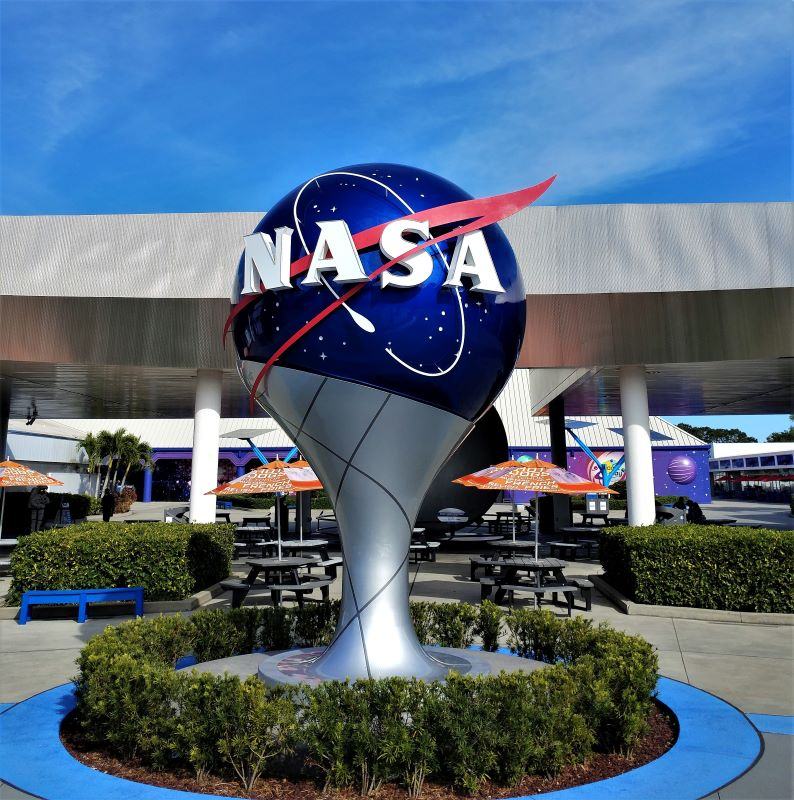
Space Programs
I will outline some of the exhibits at the Kennedy Space Center Visitor Complex and briefly explain the space program. Then, I will tell you about seeing our launch (and the picture at the top of this post).
Rocket Garden
Near the main entrance of the Kennedy Space Center Visitor Complex, which you can see from the parking lot, is the rocket garden. These are real NASA rockets all on display.

We watched a Falcon 9 rocket launch (it was not exhibited in the rocket garden or on display for photos). The Falcon 9 is about three times taller than the Redstone Mercury.
Mercury
Allen Shepard was the first American to successfully ride a Mercury/Redstone rocket to space in 1961. John Glenn made the first three laps around the earth in orbit, alone riding in the Mercury capsule in 1962. I was too young to appreciate these accomplishments. I started taking notice of the space program when the swimming pool in Boulder was named after the Mercury Astronaut Scott Carpenter.
Gemini
I started paying more attention to the space program with the Gemini program, which sent two astronauts into space on the same Atlas rocket. In the Gemini program, the Astronauts could exit the capsule in space and move around the outside of the capsule in their spacesuits. The media called this a spacewalk, although perhaps a space float would have been a better description.
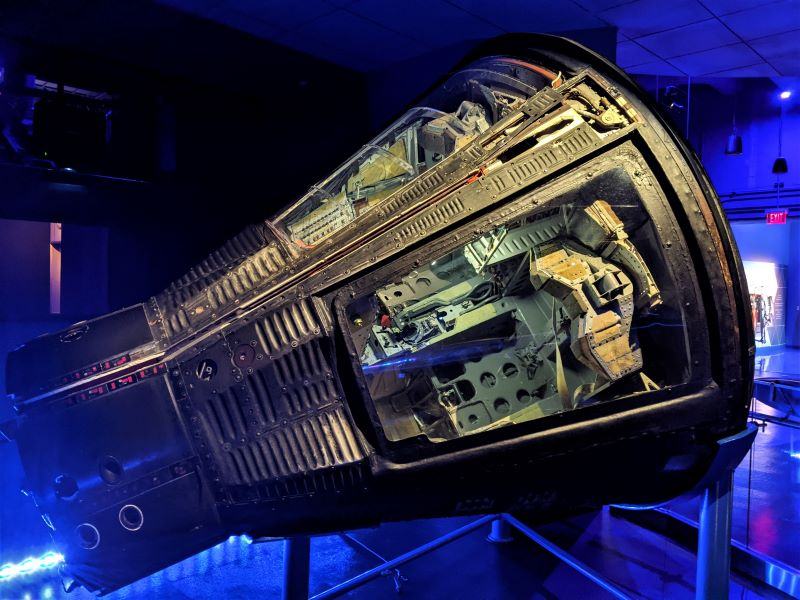
The Heros and Legends exhibit is a great place to see stories about the astronauts. This especially applies to the Mercury and Gemini astronauts.
Apollo
Other than a couple of exhibits, most of the Apollo missions are at the Apollo/Saturn V Center. This exhibit is at the halfway point of the bus tour. This trip to the Apollo/Saturn V Center is a must-see attraction. Please don’t skip it. After admission, we went straight to the bus and were among the first to arrive at the Apollo/Saturn Center that day.

Inside a very long building is a full-size Saturn V rocket. As you enter the building, you will see rocket engines mounted at the tail end. The Saturn V engines are the largest rocket engines successfully used — ever. These engines are much more powerful than the Space Shuttle engines. They also lifted the most weight of any rocket engine ever made. The record stands at over three hundred thousand pounds lifted into orbit (and beyond). In comparison, the Mercury/Redstone weighed less than seventy thousand pounds.
A much bigger rocket engine was created in the Soviet Union but failed on each of five launch attempts.
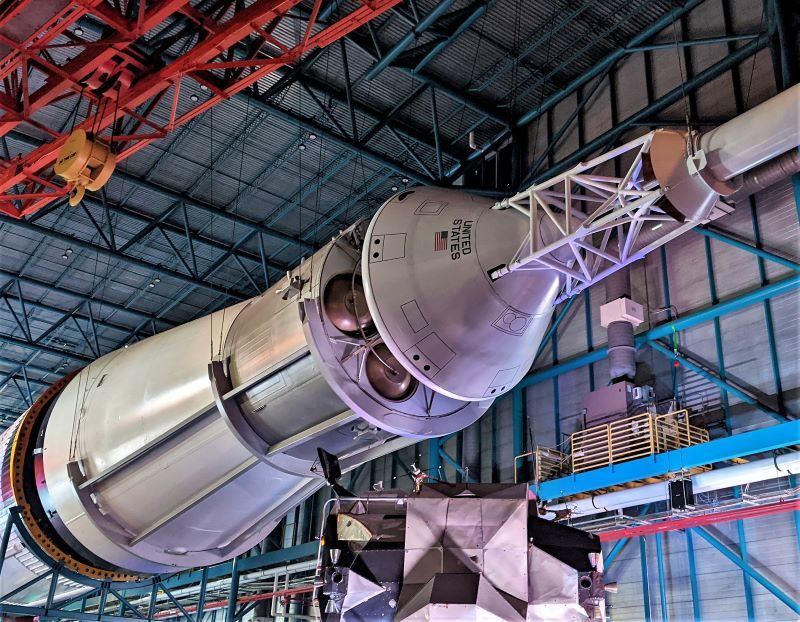
The Saturn V rocket, which carried the Apollo missions to the moon, is nearly five times taller than the Redstone/Mercury rocket. It hangs horizontally from the roof inside the building. In front of the capsule is a needle-like tip that precedes the capsule. Behind the capsule is the payload section that includes the lunar lander (and lunar dune buggy used on later trips). Everything behind these sections is rocket and fuel.
Not reusable
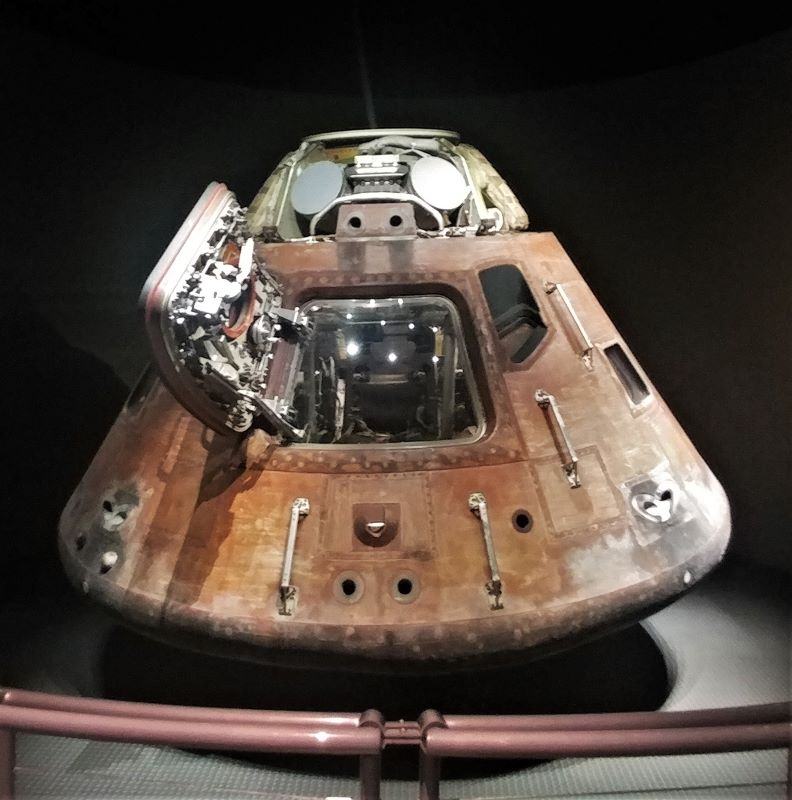
Besides the first stage of Saturn V, which is jettisoned about 42 miles above the Earth, everything else, including the space capsule (pictured above), is discarded farther into space. This includes the lunar lander. Beginning at takeoff, the only purpose for a used space capsule is as a museum exhibit.
Mission Control
Launching a moon mission takes an entire team, and most team members never leave Earth. This picture is of the Apollo Mission Control Room. NASA moved the control room here from Houston and rebuilt it at the Kennedy Space Center Visitor Complex.

Lunar Lander
Another great exhibit at the Saturn V / Apollo Center is the Lunar Theater. This is a replay of the actual communications between the Apollo Eleven moon landing when Niel Armstrong and Buzz Aldrin landed and then walked on the moon. During the replay, an actual full-scale lunar lander descends to the moon’s surface, and then, as you watch, Neil Armstrong in a full space suit fades into view along with the Stars and Stripes planted forever on the moon’s surface.

Space Shuttle
Although the Space Shuttle doesn’t have the glamor or history of the moon landing, it has one feature that every space program in every country can’t match. In a Space Shuttle, the astronauts fly the landing and touch down on a runway.

The big thing missing from the above picture is the Space Shuttle. It is inside the building on display. The large orange cylinder in the middle is the fuel tank. On each side of the fuel tank are two solid rocket boosters. The boosters provide the extra thrust required during the launch to lift the shuttle and fuel tank on their way through the atmosphere. The fuel inside the orange cylinder is liquid hydrogen. A separate tank of liquid oxygen is inside the fuel tank. These two elements are simultaneously ignited in the Space Shuttle engines as the boosters provide liftoff. The hydrogen/oxygen combination creates tremendous thrust. After burning, the “smoke” is water vapor.
Power
Even though the shuttle is massive and very powerful, its combination doesn’t match the enormous power of the Saturn V rocket. The difference is noticeable. With the shuttle, the goal is to orbit the Earth, just like the Mercury program. The Saturn V rocket had the goal of orbiting the moon, which is much further away.


Mission
The space shuttle is designed to take heavy objects into orbit. This includes the International Space Station and satellites like the one in the following picture at the Smithsonian Air and Space Museum in September.

Landing the Space Shuttle
As we all know, the space shuttle landed like an airplane (actually a glider). The pilots used all the fuel to slow down while still in space. All the fuel had already been expended as the shuttle reentered the atmosphere. The last drop of fuel was expended to slow the shuttle down, and this caused the altitude loss needed to reenter the atmosphere. From there, they glided halfway around the world to arrive over Florida at about 37,000 feet at 345 miles per hour. This was the first time the astronauts saw the runway.
Simulator and practice
I think everyone knows that I am a naval aviator. After retiring from the Navy, I taught Navy pilots in simulators for the next twenty years. Each astronaut has practiced landing the space shuttle more than 1,000 times. They practice takeoffs and landings in simulators. They also perform approaches in a specially modified Gulfstream jet that descends like the space shuttle.
The Gulfstream, used to train the astronauts, flies the shuttle approach profile with its engines in reverse. This requires a very nose-low approach to the runway to keep the speed high enough to match the decent profile of the space shuttle. Passing through 37,000 feet, the shuttle pilot starts his approach profile. Think of it like an airline pilot announcing his descent to make his landing and turning on the fastened seat belt light. Commercial airliners also use the mid-30,000-foot altitudes for mid-flight cruising.

The shuttle pilot will then make a maneuver that every Naval Aviator learned before he was ever allowed in an airplane. To do this you make a gentle wide turn while descending to align yourself with the runway. Just before touchdown you reduce the speed and lower the landing gear. After that touch down gently.
Since the shuttle has short wings, it doesn’t make a very good glider. After passing through 37,000 feet and beginning its approach, the shuttle touches down on the runway in less than three and a half minutes. It then lands at 225 miles per hour—compare that to your last airplane flight.
The Future of Space Flight
The future of space flight doesn’t include pilots landing spacecraft on runways. Instead, they are going back to the original capsule design. Instead of reusing the space capsule, they are starting to land the rockets back on recovery pads. SpaceX has taken off and reused the Falcon 9 rocket booster that we saw during our space launch eight previous times.

This Orion capsule will sit atop the Space Launch System (SLS) rocket. The SLS will provide heavy-lift duties for future missions to the moon and Mars. Space Launch System has scheduled a first test flight for an SLS rocket for February 2022. We plan to be in Orlando at about the right time. If it looks like a go, we will drive back to Kennedy and try to see it. Why? An SLS rocket is going to be more powerful than a Saturn V.
Our Space Launch story
Our Space Launch story starts with a two-week disappointment. Since our visit to the “Space Coast” was planned nearly six months ago, I guessed wrong. The week I scheduled to be closest to Kennedy didn’t have any launches. I had hoped to get a picture of a space launch with our RV in the picture.
I planned several stops along the Space Coast so that we would be in driving range for a space launch. Two weeks after we departed our closest location, we got lucky. We drove for more than an hour back to Cocoa Beach for a 6 p.m. space launch. We parked on I Dream of Jeannie Lane. Fifteen minutes before takeoff, we set up on the beach south of Cape Canaveral.
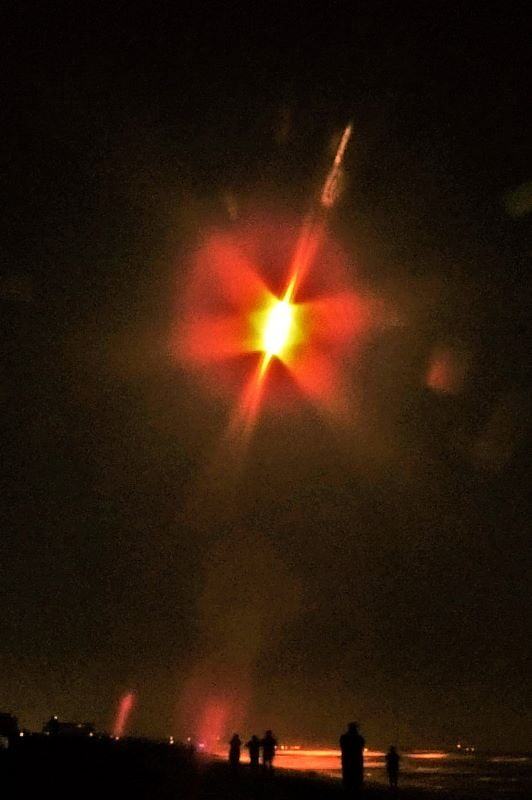
Space Launch photo
As you can see in the picture (also at the top of this page), a few people were on the beach closer to the launch than we were. The Falcon 9 rocket took off heading toward the east and then turned north for this launch. It was carrying 48 satellites. The report is that the mission was a complete success, including the return of the booster section to a recovery pad nine minutes after takeoff.
Here is a video of a Falcon 9 rocket landing. Youtube SpaceX
As for the picture, I knew I wouldn’t get a fire trail leading across the sky because I don’t have that level of experience shooting space launches. Instead, I got pretty much what I expected. I am thrilled you can make out the rocket. Getting a picture of the fireball was easy. As for the people on the beach, that was luck, all because the rocket was low enough to include them in the picture. Just after this picture, the rocket turned north, and all we could see was the fireball.
Please subscribe and join us on our journey.
We will add you to our email list and send you updates once a week. Here is a link. Subscribe
About our links
Our blog income is zero, allowing us to be independent and tell the truth. We do not get income or commissions. No, we don’t make paid endorsements. We don’t make recommendations; instead, we will tell you what we like (or dislike). The links are only provided as a quick reference to help our readers.
Links
Kennedy Space Center Visitor Complex
About Comments
We love seeing your comments, but they are not automatic. I get about twenty spam comments daily, so I don’t have automatic comments. I read and then publish every comment personally to protect the blog and keep it on-topic. So this means that you will not see your comment right after you hit submit. Sorry for the delay in publishing your comments. Please know that we would love to hear from you.

Lots of great info and pictures but I was also interested in hearing about where you stayed.. nearby? campground? recommendations etc. Anyway, thank you for all of the other info.
Thanks, Bonnie, I will be filling in the Campsite Review section of the website soon. The closest place that we stayed to the Kennedy Space center is Wickham Park.
Tami does a quick “where we are” on her Facebook page and links FoxRVTravel Facebook site to her account.
KSC remains one of our all time favorite stops during our travels. It is just awesome! I am super jealous that you got to see a launch. There was supposed to be one while we were visiting, but it was scrubbed because of weather. Such a bummer. Glad you all got to see one!
So are we, now I want to see another.
Great pictures & interesting history. Thanks.
We continue to enjoy your travels, stay healthy & SAFE. 🤗❤️
Thanks
I don’t know how you keep outdoing your previous post but you do.
I have only been to two space centers, Red Stone, AL, and Houston,
TX. My husband has been to three, this one included, but since that was 52 years ago, I am sure it has changed!
Awesome read and pictures.
Thank you
Thanks, Brenda, I am so glad you enjoy it.
We stopped by in the spring and the launch we were hoping to see got delayed and we couldn’t extend our stay, so our rocket launch goal has been pushed out again.
Great picture!
We want to go back again and again.
Great pics and memories…
I was at the Cape on one of my 82′ minehunters doing some underwater security stuff for one of the shuttle launches– and we were very surprised at how hard we got knocked around by the blast (a lot more than they said we would at the distance we were from the pad– slightly less than 1 mile). Bluntly– we got pounded! Later on, Kathy and I took our daughter up for a nighttime shuttle launch– got to go to the pre-launch brief and sat in the VIP section with the astronauts’ families…. quite a show.
Enjoy the Sunshine State!
This is a great story Max. Thanks for sharing it. I assume the VIP seating is awesome.
You bet it is… and for a night launch for the couple of minutes before T=0 it is so dark that you cannot see the person next to you… and then when those big engines light off you can easily read a magazine for several seconds!
You know, Ted and I wintered are Manatee Cove in 2020/21 (Patrick). We saw lots of launches, day and nighttime, by just walking out our front door. But we drove to cocoa beach, too, sometimes. It was great. I still have the app on my phone for the alerts.
I think I am going to need that app. At Manatee Cove you probably had a great viewpoint. We worked our way a little closer, just because we could
Thanks for the update. I’ve watched & heard the changes in humanity’s space adventures since sputnik.
Yet today’s “details” seem inadequate compared to the past. The technology gap leaves the human part out & from “janitor to astronaut” we miss out.
Pix of the museums you see step the humanity part up several orders as we wonder who made that piece, who’s thought began the process to make it real.
We’ve enjoyed going thru a few of the many museums.
Evergreen, though not on par with KSM etc, was there just last month.
Thanks again, keep them coming.
We stayed behind Evergreen in McMinnville in our RV. We also stayed at the RV park right next door. Here is the story about our stay. When in the Navy I am pretty sure that I rode to Japan in one of Evergreens 747s.
Here is the link to that blog post.
https://foxrvtravel.com/mcminnville/
I noticed that four out of five astronauts that you named were Naval Aviators. Just saying.
It wasn’t intentional. There were lots of Naval Aviators in the first astronaut group.
In the 1980s I was stationed in Orlando at the Navy Recruit Training Center (boot camp). Each week we had a graduation ceremony for the new sailors. Anyone who has ever attended boot camp will tell you that boot camp is both mentally and physically challenging. Every recruit puts forth tremendous effort in his transition to becoming a sailor. The graduation ceremony is a very emotional event for both the new sailors and their families. For many sailors, this will be the first time they have seen their families in months.
Cape Canaveral is about 25 miles away. If you looked due east you could see the Space Shuttle launch. Not only could you see the launch but you could also hear the rumble of the rockets.
One day we were very lucky that the launch was scheduled at the same time as one of our Recruit Graduation Ceremonies. On the stage and grandstands, we were facing east along with all the guests and proud parents. The recruits were standing in ranks, all in dress whites, all facing west. We knew about the launch schedule and I discussed it with our guest speaker who was an Admiral before the ceremony.
At T-minus zero, right on schedule, I approached and interrupted the Admiral who was in the middle of his speech. Anyone in the military understands that this just doesn’t happen. Then our Command Master Chiefs voice roared over the presentation — RECRUITS ABOUT FACE.
Just then in full view of hundreds of graduating recruits, parents, and guests the Space Shuttle billowing exhaust rose gently above the barracks building soaring into the sky. Just after that, the roar of the rockets engulfed the parade grounds. The sound was chest shaking. At the same time, the guests, families, and sailors all cheered.
The launches were unbelievable and the Admiral was upstaged but beaming with pride.
I bet these sailors are telling their children and grandchildren this story. Thanks
We saw a rocket launch in California right after sunset. We were in Santa Barbara and the rocket went south after launch. We never actually saw the rocket because it was too high.
The vapor trail, still in the sunlight against the dark sky was spectacular.
That is really cool.
That must have been a GREAT visit. Thanks for sharing the stories.
It was a great time. I hope that we get to go back for another launch.
Thanks guys. This was pretty cool.
Pingback: Astronaut Bill Anders amazing Heritage Flight Museum - FoxRVTravel
Pingback: Top Secret Titan Missile Museum - FoxRVTravel